

Helping People Preserve Historic Places
- HHF Mission, Vision & Principles
- Our History
- Board of Trustees
- 2023 Annual Meeting & Elections
- Annual Reports
- IRS Form 990
- Press Center
- HHF in the News
- Older Newsletter Archives
- What is Preservation
- Why Preserve
- Preservation Articles
- Trends and Issues
- Most Endangered Sites
- Preservation Awards
- Kama‘āina of the Year™
- Heritage Tourism
- Advocacy News
- Get Involved
- Hawaii County Historic Properties
- Maui, Molokai & Lanai Historic Properties
- Oahu Historic Properties
- Kauai Historic Properties
- Historic Property Inventories & Context Studies
- Guide to the Hawaii Historic Register
- Facts and Myths
- Tax Information
- Historic Residence Signs
- Buying or Selling A Historic Home
- How to Research the History of Your Home
- About the Resource Center
- Economic Benefits
- Ask an Expert
- Preservation Briefs
- Funding Sources
- Tools & Resources
- Native Hawaiian Organization Stewardship Training
- Past Events
- Historic Hawai‘i Foundation 50th Anniversary Gala
- 2023 Annual Fund Campaign
- Become a Member
- Monthly Giving – Wahi Pana Stewards
- Leave a Legacy
- Become a Sponsor
- Other Ways to Give
- HHF Gift Shop
- Donor Privacy Policy
MATSON THROUGH THE YEARS
Matson through the ages.

Matson Company History
Matson Navigation Company’s long association with Hawaii began in 1882, when Captain William Matson sailed his three-masted schooner Emma Claudina from San Francisco to Hilo, Hawaii, carrying 300 tons of food, plantation supplies and general merchandise. That voyage launched a company that has been involved in such diversified interests as oil exploration, hotels and tourism, military service during two world wars and even briefly, the airline business. Matson’s primary interest throughout, however, has been carrying freight between the Pacific Coast and Hawaii.
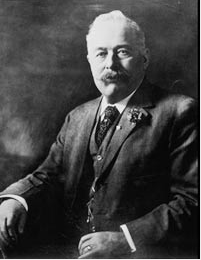
In 1887, Captain Matson sold Emma Claudina and acquired the brigantine Lurline , which more than doubled the former vessel’s carrying capacity. As the Matson fleet expanded, new vessels introduced some dramatic maritime innovations. The bark Rhoderick Dhu was the first ship to have a cold storage plant and electric lights. The first Matson steamship, the Enterprise , was the first offshore ship in the Pacific to burn oil instead of coal.
Development of Tourism
Increased commerce brought a corresponding interest in Hawaii as a tourist attraction. The second Lurline , with accommodations for 51 passengers, joined the fleet in 1908. The 146-passenger ship S.S. Wilhelmina followed in 1910, rivaling the finest passenger ships serving the Atlantic routes. More steamships continued to join the fleet. When Captain Matson died in 1917 at 67, the Matson fleet comprised 14 of the largest, fastest and most modern ships in the Pacific passenger-freight service.
When World War I broke out, most of the Matson fleet was requisitioned by the government as troopships and military cargo carriers. Other Matson vessels continued to serve Hawaii’s needs throughout the war. After the war, Matson ships reverted to civilian duty and the steamers SS Manulani and SS Manukai were added to the fleet – the largest freighters in the Pacific at that time.
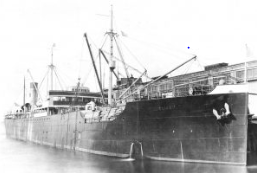
The decade from the mid-1920s to mid-30s marked a period of significant expansion for Matson. In 1925, the company established Matson Terminals, Inc., a wholly owned subsidiary, to perform stevedoring and terminal services for its fleet. With increasing passenger traffic to Hawaii, Matson built a world-class luxury liner, the S.S. Malolo, in 1927. At the time, the Malolo was the fastest ship in the Pacific, cruising at 22 knots. Its success led to the construction of the luxury liners Mariposa , Monterey and Lurline between 1930 and 1932.
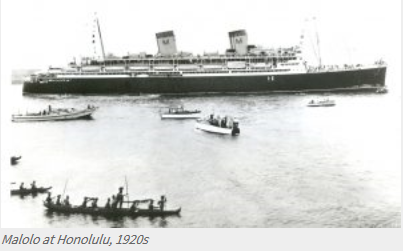
Wartime Service
Immediately after the December 7, 1941 attack on Pearl Harbor, the passenger liners Lurline , Matsonia , Mariposa , and Monterey , and 33 Matson freighters were called to military service. Matson, as General Agent for the War Shipping Administration, was given the responsibility for manning, provisioning, maintaining and servicing an important part of the government’s rapidly expanding fleet of cargo vessels.
Matson was soon operating a fleet of more than one hundred vessels. Matson’s four passenger liners completed a wartime total of 119 voyages, covered 1 1/2 million miles and carried a total of 736,000 troops. As 1945 ended, the roster of 35.
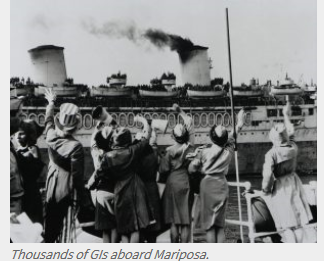
Innovation in the Pacific

The company’s historic contribution to the maritime industry is prominently featured in an exhibition at the Smithsonian National Museum of American History in Washington, D.C., entitled “Transforming the Waterfront.” The display includes authentic 1970-era Matson containers, with a backdrop mural of Matson’s Oakland container yard at night. The exhibition also addresses the impact of containerization on West Coast waterfront operations, including the historic Mechanization and Modernization Agreement of 1960. To learn more about the exhibit, please click here.
Containerization brought the greatest changes to water transportation since steamships replaced sailing vessels. And it came just in time to save the American Merchant Marine from going down with all hands under the burden of rapidly-rising costs and foreign flag competition.
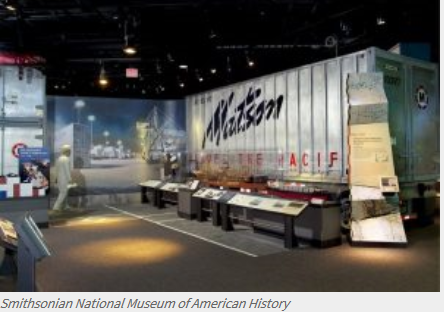
That vessel, the S.S. Hawaiian Enterprise (renamed Manukai ), and its sistership, the S.S. Hawaiian Progress (renamed Manulani ), entered service in 1970 and marked the beginning of a new generation of containerships. The gains in productivity and efficiency were remarkable. In 1950, an average commercial vessel could carry 10,000 tons at a speed of 16 knots. Following the development of containerization, the average commercial vessel carried 40,000 tons at a speed of 23 knots. Concurrently, shoreside innovations were introduced, including the world’s first A-frame gantry crane, which was erected in 1959 in Alameda, California and became the prototype for container cranes. In addition, Matson introduced the first transtainer by Paceco and the first straddle carrier in the world by Clark Ross – both developed to meet Matson specifications.
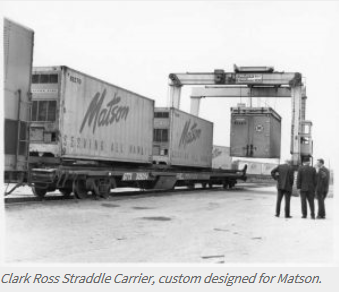
Back to Roots: Lifeline To a Growing Hawaii Economy
With the focus on containerization growing, Matson divested itself of all non-shipping assets, including its Waikiki hotels, which were sold to the Sheraton Corporation in 1959. In 1969, Matson became a wholly owned subsidiary of Honolulu-based Alexander & Baldwin, Inc., strengthening the business ties that formally date back to 1908, when A&B invested $200,000 to acquire a minority interest in Captain Matson’s company. In 1970, in line with the decision to concentrate on its Pacific Coast-Hawaii freight service, the company sold its passenger vessels and suspended its Far East service, which had commenced a few years earlier.
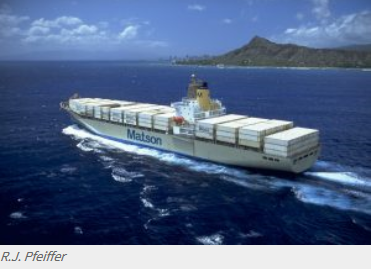
Equally important, Matson focused on developing an industry-leading Customer Service Center in the 1990s, providing customers with “one call does it all” customer service. That effort resulted in the creation of a Customer Service Center in Phoenix in 1995. The philosophy behind centralized customer service was extended to the Internet in subsequent years, allowing customers to have the same “ease of use” in doing business with Matson online as they have with dedicated customer service teams.
Diversification
In 1987, Matson formed Matson Intermodal System, Inc. as an intermodal marketing company (IMC) arranging rail and truck transportation throughout North America for shippers and carriers. The company grew steadily through the ‘90s and gained industry recognition as one of the nation’s leading IMCs.
In 2003, the company was renamed Matson Logistics in recognition of its continued growth and expanded service offerings. In 2011, the company rebranded itself as Matson Logistics and continued to develop as a leading provider of multimodal transportation services to the North America market, including domestic and international rail intermodal service, long haul and regional highway brokerage, supply chain services and less-than-truck load (“LTL”) transportation services, as well as third-party logistics services that encompass warehousing, distribution, and international freight forwarding.
In 1999, Matson and Stevedoring Services of America, Inc. (SSA) appointed SSA Terminals as the manager of terminal and stevedore operations at Matson Terminals, Inc.’s facilities on the West Coast. MTI continues to operate Matson’s container stevedoring and terminal services in Honolulu.
Beginning in 2002, Matson embarked on an ambitious four-ship construction program, which involved investing more than $500 million in new containerships that significantly modernized the company’s fleet. With the new ships, the company developed a successor to its Guam service, which was operated as a joint alliance service with APL from 1996 – 2006. The new service included stops in Honolulu and Guam, as well as expanding Matson’s geographic reach in the Pacific to include China. The China – Long Beach Express (CLX) was inaugurated in 2006, with service from Ningbo and Shanghai to Long Beach. In 2009, Xiamen was added as a port call.
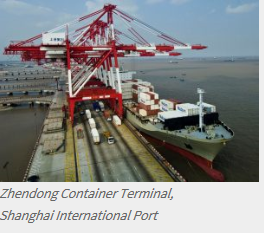
In 2012, after 43-years as a subsidiary of A&B, Matson separated from its parent company, forming Matson, Inc. and began trading its shares on the New York Stock Exchange (NYSE) under the ticker symbol MATX.
Matson launched Matson South Pacific (MSP) in 2013 after it acquired Auckland, New Zealand-based, Reef Shipping. Beginning with service from Auckland and Fiji to the island nations of Nauru, the Solomon Islands, Tahiti, Samoa, Cook Islands, Niue, Tonga, Wallis, Futuna, Vanuatu, Tarawa and Majuro, service later expanded to include service from Brisbane to the Solomon Islands and Nauru.
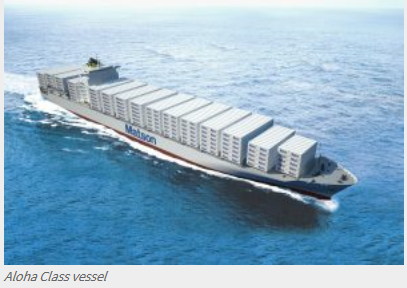
The first two ships, scheduled for delivery in 2018 and 2019, were classified the Aloha Class and named Daniel K. Inouye and Kaimana Hila , respectively, in honor of Hawaii’s late senior senator and his ardent support of the U.S. maritime industry.
The third and fourth new ships, scheduled for delivery in 2019 and 2020, were classified the Kanaloa Class and will be named Matsonia and Lurline , historical names that have been maintained in Matson’s evolving fleet for more than a hundred years.
Having been interested in the Alaska market for some time, Matson fulfilled the opportunity to add this natural extension of its Pacific services in 2015 with the $469 million acquisition of the Alaska operations of Horizon Lines, Inc. This added the Alaska ports of Anchorage, Kodiak and Dutch Harbor to the network, along with seven Horizon vessels – three diesel vessels (D7) and four steamships. The D7s were refurbished, rebranded and renamed Matson Anchorage , Matson Kodiak and Matson Tacoma , while one steamship was held as a reserve vessel and the others retired.
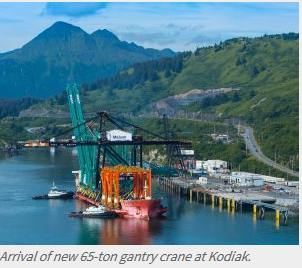
Matson for the first time linked its northern Pacific network with its South Pacific operations in 2016 with the introduction of its South Pacific Express (SPX) service between Honolulu, Samoa and American Samoa, creating a contiguous network spanning the Pacific. The company continued investing in the Alaska market with the acquisition of Span Alaska, a market leading provider of Less-than-Container Load (“LCL”) freight consolidation and forwarding services to Alaska, as a subsidiary of Matson Logistics.
- The Last NORTH ATLANTIC Ocean Liners
- Last Ocean Liners to AFRICA & LATIN AMERICA
- To AUSTRALIA, FAR EAST & AROUND-the-WORLD
- SAILING SCHEDULES January to December 1966
- RANK & COMPARE the Last Ocean Liners
The Last Ocean Liners
Matson lines, mariposa / monterey / lurline.
To the ship profiles
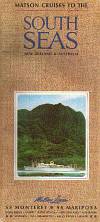
Mariposa and Monterey were both sold to Pacific Far East Line in 1971 who continued the South Pacific service with minor route variations. Cruises to Hawaii and later to Alaska and further afield were added to the annual schedule in the 1970's.
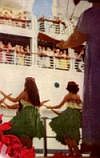
Both of Matson Lines' Lurline 's were sold in turn to Chandris Lines of Greece who renamed them Ellinis and Britanis , respectively. The two ocean liners were converted to carry over 1,600 tourist class passengers each on line voyages between Europe and Australia and around-the-world.
Sample minimum one-way fares from San Francisco to Honolulu: First class $230; from San Francisco to Sydney: First class $886; All fares are per person in U.S. dollars.
Go to Matson Lines sailing schedules or select schedules by ship below:
Matson Line was formed in 1882 by Captain William Matson to operate the Hawaiian trade. In 1926 the Oceanic Steamship Co. was purchased and became a Matson subsidiary. The company thus extended it's sphere to Australia, New Zealand, Pacific Islands and the Far East.
Abbreviation: LASSCO Los Angeles S.S. Co.
Many thanks to Ted Finch for his assistance in collecting this data. The following list was extracted from various sources. This is not an all inclusive list but should only be used as a guide. If you would like to know more about a vessel, visit the Ship Descriptions (onsite) or Immigrant Ship web site.
How Louis Macouillard’s watercolors of Hawaii, California and the South Pacific inspired a life of travel
- Show more sharing options
- Copy Link URL Copied!
Grace Harrison fell in love with Louis Macouillard based on his artwork.
Nearly two decades later, so did I.
Harrison, an advertising copywriter in San Francisco, was mesmerized by the watercolors that her boyfriend, who was serving in the U.S. Navy during World War II, sent home to her in the States. They depicted exotic tropical lands and included South Pacific life in New Caledonia and the Solomon Islands.
The detail is astonishing — down to the wooden kola-kola bird pictured atop a home on Savo Island, part of the Solomons.
The watercolor courtship worked, according to a 1943 Life magazine cover story about the couple. She and Macouillard married in July of that year, and they remained together until his death in 1987. She died in 2000.
As a child, I fell under the spell cast by the menu covers Macouillard created for Matson Lines, and I spent the next half-century staring at images depicting an oft-exotic outdoors, first in my parents’ home, then in my mother’s, now in mine.
They were a sort of early social media, highly shareable (seemingly everyone had a set judging by the numbers available on eBay) and exceptionally visual.
Macouillard, a Bay Area native, became a commercial artist after the war and worked for various entities, including Matson. He was the last of the Matson “menu men” whose images fronted the passenger ships’ elaborate daily offerings. (Rainbow trout or pheasant, anyone?)
Matson works by Frank McIntosh, John Kelly and Eugene Savage preceded Macouillard’s and are better known. They’re more intricate, sophisticated, powerful.
All played a role in creating the dream that drew people to Hawaii when it was still a territory, but it was Macouillard’s works that won my affections almost from the moment the Matsonia liner sailed us to Hawaii in 1961.
By then Hawaii had become a state; a decade later, Matson would stop carrying passengers from San Francisco and Los Angeles to Honolulu and beyond. Jets delivered tourists in five hours instead of the five days it took the gleaming Matson ships.
At the Oakland offices of Matson, now just a shipping company, two original Macouillard menu covers were hanging in an office when I visited in August; four were stored in a closet. By contrast, the much more vibrant and valuable Savage works hang in the hallways.
The Savages are oils; Macouillards are watercolors, a form that is not always as prized but is more welcoming to beginners.
In 1961 I was a beginner, a newcomer inextricably drawn to Hawaii and later, like many Baby Boomers, to travel.
Macouillard’s magic remains part of that siren song that lures me to places I might not ordinarily go.
I can, for instance, catch a glimpse of a hybridized Macouillard on “Hawaii Five-O” (the reboot). If you look closely, you can spot it on an office wall when the detectives are working inside. It’s a blurring of Macouillard’s Hawaii hukilau — net fishing — work and the Tahiti print; Lynn Blocker Krantz, a Southern Californian and a Matson historian, blended the two pieces, which have had a cameo in the TV show for the last six years.
Or I can conjure up an image of a recent visit to the Bank of America in San Mateo, Calif., where a large, stunning mural designed by Macouillard and created in the early 1960s covers the front of the A.P. Giannini building. It tells the story of the BofA founder’s beginnings, of California and of the Giannini Foundation, which supports California agriculture.
Or I can look at those menu covers and wonder when I’ll get to Fiji or Samoa or New Zealand or when I can return to Australia — all by way of Hawaii. Naturally.
Romanticized, stereotyped beauty on the Matson cover menu
Idealized, stereotypical beauty. It’s what’s for dinner.
These covers of Matson menus, painted by Louis Macouillard, portray a romanticized version of the destinations the line served. The descriptions — “captions,” as it were — paint word pictures that are sometimes laughable and other times offensive.
A Fijian’s grandfather is “a fierce barbarian,” one blurb reads. “Samoans have been exposed to civilization,” that descriptor notes, but “many still cling to their thatched hut villages.”
People in general and Hawaiians in particular tend to be more forgiving of such artwork, especially when viewed through a modern prism, said DeSoto Brown, a historian at Honolulu’s Bishop Museum.
“Most Hawaiians saw them as really pretty pieces of art, for the most part,” Brown, a fourth-generation resident, said of the menus.
“Because this older artwork has this nostalgic air to it, a lot of people who would be really critical today will look at this older stuff with affection… and not take it seriously.”
Some tidbits included in the “about the covers”
“The only island continent, the first created and the last discovered, with much to stir your curiosity….. Friendly and fun-loving, Australians breed champions at golf and tennis.”
“You see in Suva a modern seaport…but only a short drive away you discover jungle-hidden villages where Fijians still live in thatched huts and kava ceremonies and ritual dances take you back to a bygone age.”
“You mingle in the colorful seashore life centered at world-famous Waikiki hotels, watch an entire village make a gala festival out of a fishing excursion, the hukilau; hear wistful Hawaiian melodies and find yourself spellbound by the enchantment of Polynesia.”
New Zealand
“Nature has taken counterparts of the greatest scenic wonders of every continent and arranged them in beautiful patterns on two large islands….To a remarkable degree, New Zealand is truly a world in itself.”
“Your ship…sails into lush loveliness of Pago Pago harbor….A stalwart fita-fita (native policeman) is happy to tell you where to shop for kava bowls and tapa mats…”
“Tahiti remains the unspoiled, exquisite Bali Hai of timeless South Sea lore… a dreamland to those who have never seen it and a haunting memory to all who have.”
San Francisco
“Standing on an eminence, you see over the jagged line of skyscrapers the magnificent sweep of San Francisco Bay, traversed by two world-famed bridges and dotted by watercraft of every kind. And you hold your breath, enthralled.”
Southern California
“You can drive from a snow-capped peak to a sunswept beach in a couple of hours. You can ride horseback down a rockbound canyon in the forenoon, roam entranced through Disneyland in the afternoon, and dine in a rendezvous of movie stars in the evening…. Wish for the travel thrill you want, and Southern California will quite likely produce it.”
More to Read

‘Something more dream-like’: These butterflies tell an unexpected story about migration
April 22, 2024

A mysterious photographer of the Civil War, under a new microscope
April 18, 2024

The L.A. island that was home to seven decades of ‘lost communities’
April 9, 2024
Sign up for The Wild
We’ll help you find the best places to hike, bike and run, as well as the perfect silent spots for meditation and yoga.
You may occasionally receive promotional content from the Los Angeles Times.

Catharine Hamm is the former Travel editor for the Los Angeles Times and became a special contributor in June 2020. She was born in Syracuse, N.Y., to a peripatetic family whose stops included Washington, D.C.; Honolulu; and Manila. Her varied media career has taken her from McPherson, Kan., to Kansas City, Mo., San Bernardino, Salinas and L.A. Hamm has twice received individual Lowell Thomas Awards, and the Travel section has been recognized seven times during her tenure as editor. Her favorite place? Always where she’s going next.
More From the Los Angeles Times

How to have the best Sunday in L.A., according to Laufey
April 26, 2024

World & Nation
Venice tests 5-euro entry fee for day-trippers as the city grapples with over-tourism
April 25, 2024

Travel & Experiences

This must be Larchmont

What to know about California’s new state park, a scenic green space where two rivers meet
April 23, 2024
Cruising The Past Cruise News
Coulter’s steamlined modern department store miracle mile los angeles.

PEARL HARBOR – December 7th 1941… Matson Line’s SS LURLINE…
Posted by: Michael Grace December 7, 2015
- The SS Lurline made her destination safely, cruising at maximum speed, and soon returned to Hawaii with her Matson sisters SS Mariposa and SS Monterey in a convoy laden with troops and supplies.
- December 7, 1941, was a turning point in the history of the United States, which had been teetering on a decision between isolationism and intervention.
- It can be argued that every USA military engagement since then has been affected by what happened when America learned that it was not possible to stand by and watch war among strangers without being at risk of becoming involved whether they wished to be or not.
Cruise History and Liner History: The SS Lurline was half way from Honolulu to San Francisco on 7 December 1941, when the Japanese bombed Pearl Harbor.
What about all the American ships that were at sea on December 7th? The United States Lines, Grace Line and Alaska Line steamships. There were over a 100 US flag passengers ships at sea when World War 2 was declared.
Another shipboard view of the SS Lurline her normal cruise route bound for San Francisco, 5 December 1941. Two days later the USA was at war. And the famed liner SS Lurline was rushing back to the San Francisco and the safety of California.
Youtube video – Sailing day on the SS LURLINE – from Honolulu, Hawaii… memories now vanished.
The SS Lurline docking at San Diego’s Broadway pier in the 1930s.
The SS Lurline was the third Matson vessel to hold that name and the last of four fast and luxurious ocean liners that Matson built for the Hawaii and Australasia runs from the West Coast of the United States. Lurline’s sister ships were SS Malolo, SS Mariposa and SS Monterey.
SS Lurline departing Hilo, Hawaii – 1960s
SS LURLINE arrival scene – Honolulu – 1941 – Months before Pearl Harbor
Sailing Day… Honolulu – 1930s…
Matson Lines and the Lurline…
Matson built a steamship named Lurline in 1908; one which carried mainly freight yet could hold 51 passengers along with 65 crew. This steamer served Matson for twenty years, including a stint with United States Shipping Board during World War I. William Matson died in 1917; his company continued under a board of directors.
Lurline Matson married William P. Roth in 1914; in 1927 Roth became president of Matson Lines. That same year saw the SS Malolo (Flying Fish) enter service inaugurating a higher class of tourist travel to Hawaii. In 1928, Roth sold the old steamship Lurline to the Alaska Packers’ Association. That ship served various duties including immigration and freight under the Yugoslavian flag (renamed Radnik) and was finally broken up in 1953.
In 1932, the last of four smart liners designed by William Francis Gibbs and built for the Matson Lines’ Pacific services was launched: the SS Lurline christened on July 12, 1932 in Quincy, Massachusetts by Lurline Matson Roth (who had also christened her father’s 1908 steamship Lurline as a young woman of 18). On 12 January 1933, the SS Lurline left New York City bound for San Francisco via the Panama Canal on her maiden voyage, thence to Sydney and the South Seas, returning to San Francisco on 24 April 1933. She then served on the express San Francisco to Honolulu service with her older sister with whom she shared appearance, the Malolo.
Film star Cornell Wilde and his wife aboard the SS Lurline in the late 1940s.
The SS Lurline was half way from Honolulu to San Francisco on 7 December 1941, when the Japanese bombed Pearl Harbor. She made her destination safely, cruising at maximum speed, and soon returned to Hawaii with her Matson sisters SS Mariposa and SS Monterey in a convoy laden with troops and supplies.
She spent the war providing similar services, often voyaging to Australia, and once transported Australian Prime Minister John Curtin to America to confer with President Roosevelt.
Lurline was returned to Matson Lines in mid 1946 and extensively refitted at Bethlehem-Alameda Shipyard in Alameda, California in 1947 at the then huge cost of $US 20 million. She resumed her San Francisco to Honolulu service from 15 April 1948 and regained her pre-war status as the Pacific Ocean’s top liner.
Only a few months later, the Lurline arrived in Los Angeles with serious engine trouble in her port turbine and was laid up with the required repairs considered too expensive. Matson instead brought the Matsonia out of retirement and, characteristically, changed her name to Lurline. The original Lurline was sold to Chandris Lines in 1963.
Popular Articles

April 3, 2024

THE LARK – All-Pullman Sleeper Train – Overnight – San Francisco to Los Angeles
April 1, 2024

California’s Old Movie Palaces New Video
March 12, 2024

Berlin’s Famous Hotel Adlon Five Stars
March 1, 2024

Judy Garland Premiere of A Star Is Born
February 14, 2024

RMS Titanic – Books Passengers Were Reading On The Doomed Voyage
© 2022-2023 The Past and Now. All Rights Reserved.
Any copying or reproduction of images or media herein is strictly prohibited.
- CONTACT MICHAEL GRACE
- Refine your search results by reviewing SEARCH TIPS
- Site tech support provided by Ted Angel

A Brief History
A synopsis of the white ships and the grand manner of matson.

S.S. LURLINE and S.S. MALOLO, San Francisco, 1933.
"The White Ships" refers to the six white-hulled steamships built and operated by Matson Navigation Company of San Francisco, beginning in 1926 with the S.S. MALOLO , and concluding in 1978 when the S.S. MARIPOSA made her last voyage flying the American flag. While the sister ships are best known for their luxury voyages between California and Hawaiʻi, they also served the islands of Polynesia, New Zealand and Australia, connecting the remote Pacific ports with modern, first class service. The influence of these ships across the region is still strong to this day.
The beautiful and beloved white ships were not Matson's first passenger vessels. The company began carrying people aboard its sailing ships starting in 1882, when Captain William Matson began his oceanic transportation empire carrying cargo to Hawaiʻi and returning to the mainland with sugar and pineapples.

Matson's first vessel, the EMMA CLAUDINA, 1882,
The rapid development of trade between the west coast, the Hawaiian Islands and the South Pacific soon led to the beginnings of tourism and migration around the region. Innovation in shipbuilding, Matson's shipping expertise and their geopolitical influence, led by Captain Matson and his loyal officers and crew, allowed the company to become the most prominent cargo and passenger service.

The first LURLINE in Matsonʻs fleet, built in 1887.

Roderick Dhu, the first ship on the Pacific with electric lights and cold storage.

S.S. Wilhelmina operated by Matson from 1910-1917 and 1919-1932.
Matsonʻs expanding fleet of ships in the late 1800s and early 1900s - powered by sail, coal, oil and eventually steam - grew bigger, faster and more accessible. American expansion saw the annexation of Hawaiʻi and strategic growth across the Pacific. The distinctive 'M' on Matson ship stacks became a familiar and frequent sight, from San Francisco to Hilo, and south to Oceania.

Meanwhile, on the east coast of the USA and in Europe, massive new trans-Atlantic passenger liners began appearing. Ships were no longer simply a means of transport, they had become grand, luxury hotels at sea. Matson was the first company to bring this new level of service to the Pacific. Their first "white" ship, designed by famed W.F. Gibbs, was the brown-hulled S.S. MALOLO, Hawaiian for flying fish. The new "Queen of the Pacific" carried 620 passengers (plus mail & cargo) and cruised at 21 knots on her five day crossings between San Francisco and Honolulu.
The keel of the S.S. MALOLO at Cramp Shipyard in Philadelphia, 1926.

MALOLO was re-named MATSONIA in 1937.

The LURLINE in 1933 on her maiden voyage from New York-San Francisco. A "South Seas & Oriental" cruise followed.
MARIPOSA, MONTEREY and LURLINE followed the MALOLO in 1932-33, operating deluxe service between California, Hawaiʻi and the South Seas on regular round trip schedules, carrying thousands across the Pacific in unprecedented style and comfort, that came to be known as the "Grand Manner" of Matson. The modern era of migration, tourism and trade was in full swing. The MALOLO and LURLINE ʻs regular ports of call included San Francisco, Los Angeles and Honolulu, while the MONTEREY and MARIPOSA continued to Suva, Pago Pago, Auckland and Sydney under Matsonʻs subsidiary, Oceanic Steamship.

The arrival and departure of a white ship in Honolulu became known as "Boat Day" - a gala ceremony that welcomed arriving passengers in the morning, and bid farewell to those sailing away in the afternoon. The festivities began as the ship rounded Diamond Head. Outrigger canoes, sailboats and motor launches accompanied the liner past Waikiki Beach, to her berth at Pier 10 beneath the Aloha Tower. Arriving passengers were welcomed with Hawaiian music and a warm aloha greeting. For malahini (newcomers) the events marked the beginning of a Hawaiian vacation. Many would stay at the famed Moana and Royal Hawaiian hotels, which Matson owned. For Hawaiian residents, or kamaʻaina, Boat Day was a wonderful "welcome home!" Later in the day, as the ships sailed on to the South Pacific or back to California, the departure ceremony was a poignant farewell attended by large crowds of well-wishers on the pier. As the Royal Hawaiian Band played "Aloha Oe", passengers threw colorful streamers and lei from the shipʻs decks, symbolic of a promise to return to Hawai ʻi again.

On Boat Day in Honolulu arriving passengers were greeted at the Aloha Tower by lei makers

As the white ships sailed, passengers threw streamers from the decks of the ship to friends and family bidding "aloha" on the pier below.

A portion of a Matson menu featuring the art of Eugene Savage.
In the 1930s, developments in color printing, and the magic of radio and film allowed Matson to share fantastic images and glowing reviews of its services to a worldwide audience. A voyage aboard a Matson liner quickly became one of the world’s most sought-after travel experiences, attracting Hollywood celebrities and heads of state along with ordinary citizens to experience "Matsonʻs Pacific Playgrounds". Newspapers around North America often featured images of local citizens aboard Matson ships. Whether on a honeymoon, business trip or migration overseas, a trip aboard a Matson Liner was an exotic adventure to a faraway place amid "the gaiety of smart, pleasure-bound people." It was an experience without parallel.

The white ships also carried cargo between their ports, some passengers even bringing their car with them. For residents of Australia and New Zealand, the fabulous new American liners offered a new option for travel to the UK or Europe, via the USA and Atlantic, rather than the long route around Africa on much less luxurious ships. The combination of Matsonʻs expertise and high standard of service, the beautiful Pacific ports of call and the comforts aboard the magnificent white ships made a trip across the South Seas one of the worldʻs finest travel experiences.
White Ships go to War

MARIPOSA in Brisbane, 1946.

Australian war bride in San Francisco,1946.
The attack on Pearl Harbor in 1941 brought the U.S. into World War 2, and an abrupt end to tourism on the Pacific. All four white ships were converted into troop carriers and served the Allies admirably around the world for the balance of the War. Matson captains and officers, among the best in the world, remained in command of the ships, which were valued for their size and speed, carrying thousands of personnel and military equipment wherever they were needed. When the War ended, the liners brought thousands of war brides from across the Pacific to their new homes in the United States.

The War took its toll on the white ships. The extensive cost of restoring them, combined with innovations in transportation and changing patterns of trans-oceanic travel, resulted in Matson reducing their passenger fleet. After returning to interim service for Matson in 1946, MALOLO (re-named MATSONIA in 1933) was sold to Home Lines and continued operating in Europe as ATLANTIC and later QUEEN FREDERICA until 1977. In 1953 Home Lines also purchased the mothballed MARIPOSA, renaming her HOMERIC. LURLINE sailed alone for Matson from California to Honolulu from 1948 until 1957, when the original MONTEREY was finally rebuilt and returned to service as the new MATSONIA .
1946 ad announcing MATSONIA ʻs interim post-war service between the US and Hawaiʻi.

The LURLINE sails from San Francisco in 1951.

As tourism and migration returned to the Pacific in the 1950s, the demand for first class travel also increased, and Matson embarked on a new approach to servicing their old routes. In 1956 they converted two relatively small cargo ships - built as Pine Tree Mariner and Free State Mariner - into modern incarnations of the MARIPOSA and MONTEREY . The twins carried on the Oceanic Steamship service beyond Hawaiʻi to the South Seas, offering round trips from San Francisco to Sydney, with new stops added at exotic island ports like Bora Bora, Moorea, Wellington, Rarotonga and Nouméa. At the time there was a lack of modern hotels in Honolulu to support the arrival of so many visitors, so Matson refurbished the Moana and Royal Hawaiian and built the Surfrider and Princess Kaiulani. Matson's "Grand Manner" was back!

The MARIPOSA arrives in Honolulu on her maiden voyage, 1956.

The MONTEREY a nchored at Noumea, New Caledonia in 1968. Photo contributed by Stephen Fleay
With their two remaining older sisters, the younger white ships continued carrying passengers over the same Pacific routes (and eventually on world cruises) into the 1960s. The popularity of Matson liners and the loyalty of their passengers were without equal. But this trend would soon see a major shift.

The new MATSONIA as photographed by Ansel Adems in Honolulu, 1957.

707's + Shipping Containers

By the 1950s, airlines became a less expensive, faster option to reach distant Pacific islands.
In 1959, Matsonʻs role as the primary mode of passenger transportation across the Pacific was confronted with a new rival. Sleek, modern Boeing 707ʻs could now travel to the remote islands of Hawaiʻi and Polynesia in hours instead of days. Many tourists opted for vacations on the beach rather than aboard ship. At the same time, Matsonʻs world-leading innovations in container shipping were a great success. Trans-oceanic liners, despite their continued popularity, began to lose their competitive edge, and were no longer a priority for shipping companies. Matson sold its four Waikiki hotels to Sheraton in 1959.

Hawaiian Merchant was the first container ship to sail from the west coast to Hawaiʻi Iin 1958.
As Matson shifted its shipping business focus back to its origins in cargo, airline travel became more widely available, and new foreign-flagged cruise ships began appearing around the world. The old "ocean liner" steamship standard of luxury travel aboard smaller vessels was becoming obsolete. The original LURLINE , following engine issues, was sold in 1963 to Chandris Lines of Greece to become the ELLINIS . The former MONTEREY - MATSONIA assumed the legendary LURLINE name to become Matsonʻs flagship and continue Caifornia-Hawaiʻi service alongside MONTEREY and MARIPOSA , which continued their South Pacific trips, along with seasonal and special cruises to Alaska, Mexico and South America.

In 1969, Matson became a wholly owned subsidiary of longtime Hawaiian business partner Alexander & Baldwin, setting the stage for what would become a change in corporate direction, and the final few years of the white ships as American-flagged liners. In 1970 the LURLINE was sold to Chandris, becoming the BRITANIS . She would continue sailing on different worldwide cruise itineraries until 1994. In 2000 she sunk near the coast of South Africa while under tow to breakers in India.

After being sold to Chandris in 1970, BRITANIS was refit and modified to carry 1,655 passengers. She operated as a cruise ship in Europe and the Caribbean, and later between New York and Bermuda, until 1994.
The sale of the MARIPOSA and MONTEREY followed soon after, although they remained in their home port of San Francisco. Pacific Far East Line purchased the twins in 1970 and operated them on their old Matson routes, with many of their original American crews remaining aboard. The ships continued sailing to Hawaiʻi and the South Pacific for PFEL. Special world cruises in the mid 1970s were fully booked. However, a 25-year subsidy from the US government that had been available since their construction was due to expire. Combined with the high cost of fuel and American crew wages, PFEL could no longer continue operating the liners. The white ship era ended on April 7, 1978, as the MARIPOSA sailed under the Golden Gate bridge for the last time.

The MONTEREY in Honolulu, 1972. Pacific Far East Lineʻs golden bear replaced Matsonʻs M on the funnel.
The MARIPOSA was sold and refit as JIN JIANG , offering cruises in China in the 1980s.
The MARIPOSA was eventually purchased by a Chinese shipping company, operating as a cruise ship / ferry between Shanghai and Hong Kong during the 1980s. The MONTEREY was laid up for nearly 10 years, when American investors acquired her from the International Organization of Masters, Mates and Pilots. In 1988, following a $50 million refit, she returned to Hawaiʻi to briefly restore her American-flag luxury service under the Aloha Pacific Cruises banner. But after just a year, the MONTEREY was again laid up due to financial problems. She found new life in Europe for Star Lauro and MSC, until engine troubles finally laid her up for good in 2006.

The White Ships author Duncan OʻBrien took a Mediterranean cruise on the MSC MONTEREY in 2001. The ship retained many of her Matson fittings and decor, including the American bicentennial banner that was added to bow in 1976.
whiteships.com is the home port for online content related to the Matson passenger ship era. It was created by Duncan OʻBrien, whose parents met on the MONTEREY in 1962. The site features images, films, artwork and memorabilia, acquired during two decades of research for his three books: The White Ships (2009), Matson the Mouse (2012), and The Grand Manner of Matson (2014). Unless otherwise attributed, all images and content on this website are copyright and reproduction is not permitted without authorization.
THE GRAND MANNER OF MATSON
50% OFF SPECIAL ONLINE PRICE
$45 incl. Shipping (North America)

THE WHITE SHIPS
by DUNCAN O'BRIEN
- 1-800-4MATSON

Lurline Photo Gallery

Client Login

IMAGES
VIDEO
COMMENTS
Emma Claudina. In 1887, Captain Matson sold Emma Claudina and acquired the brigantine Lurline, which more than doubled the former vessel's carrying capacity.As the Matson fleet expanded, new vessels introduced some dramatic maritime innovations. The bark Rhoderick Dhu was the first ship to have a cold storage plant and electric lights. The first Matson steamship, the Enterprise, was the first ...
In the 1950s, a cruise to Hawaii was sailing round-trip from California to Honolulu (alternating between San Francisco and Los Angeles) on Matson Line's SS Lurline. The first class ship made the crossing in 4 and 1/2 days. Most passengers spent 9 dqys in Hawaii before returning to the California major cities.
This website is dedicated to preserving the memory of the six magnificent white-hulled Matson Line passenger ships that sailed between California, Hawaiʻi and the South Seas from 1927 until 1978. Buy the Book from our White Ships Shop. THE GRAND MANNER OF MATSON. 50% OFF SPECIAL ONLINE PRICE.
In 1925, the company established Matson Terminals, Inc., a wholly owned subsidiary, to perform stevedoring and terminal services for its fleet. With increasing passenger traffic to Hawaii, Matson built a world-class luxury liner, the S.S. Malolo, in 1927. At the time, the Malolo was the fastest ship in the Pacific, cruising at 22 knots.
The White Ships, by Canadian author Duncan O'Brien, is the first comprehensive history of the six classic white liners operated by Matson Navigation Company ...
SS Monterey was a luxury ocean liner launched on 10 October 1931. The ship was completed April 1932 and is shown in registers as a 1932 ship. Monterey was the third of the four ships of the Matson Lines "White Fleet", which were designed by William Francis Gibbs and also included SS Malolo, SS Mariposa and SS Lurline. Monterey was identical to Mariposa and very similar to Lurline.
2022 Q3. In April, Matson received a telephone call from Carol Glazier, who was in possession of a Super 8MM film titled South Seas Cruise Adventure - S.S. Mariposa / S.S. Monterey, one of several travel films produced for Matson as part of a marketing campaign so passengers could "relive their adventures, or plan a future trip." Glazier was living in American Samoa in 1958.
The SS Malolo (later known as Matsonia, Atlantic, and Queen Fredrica) was an American Cruise liner built by William Cramp & Sons, Philadelphia in 1926 for the Matson Line. She was the first of a number of ships designed by William Francis Gibbs for the Matson Line. Films of the SS Malolo. The Matson Line did much to develop tourism in the ...
The handsome pair of ocean liners entered service in 1956 and 1957 respectively, after their conversion from Mariner class freighters. They maintained a 42-day South Pacific schedule from San Francisco to Sydney with outbound calls at Los Angeles, Tahiti, Rarotonga and Matson Lines Auckland, returning via Auckland, Suva, Pago Pago, and Honolulu.
In the 1950s, a cruise to Hawaii was sailing round-trip from California to Honolulu (alternating between San Francisco and Los Angeles) on Matson Line's SS Lurline. The first class ship made the crossing in 4 and 1/2 days. Most passengers spent 9 days in Hawaii before returning to the California major cities. It was an American flagship with ...
SS Malolo (later known as Matsonia, Atlantic, and Queen Frederica) was a passenger liner, later cruise ship, built by William Cramp & Sons, Philadelphia, in 1926 for the Matson Line.She was the first of a number of ships designed by William Francis Gibbs for the line, which did much to develop tourism in the Hawaiian Islands.In 1927, Matson commissioned its largest ship yet, the Malolo (flying ...
Historical image from Matson Lines promoting their Hawaiian hotels. Joining two Aloha-class freighter sister ships delivered to Matson in 2018 and 2019; in November 2022, the company again contracted Philly Shipyard to build three new 3,600 twenty-foot equivalent units (TEU) Jones Act-compliant container ships at a cost of $1 billion.
SS Mariposa was an ocean liner launched in 1931, one of four ships in the Matson Lines "White Fleet", ... Home Lines ocean liner and cruise ship postcards and photographs; Matson Lines 1930s brochure; Photos of twin funnel ships including SS Homeric This page was last edited on 6 April 2024, at 06:50 ...
Matson Lines' handsome pair of ocean liners entered service in 1956 and 1957 respectively, after their conversion from Mariner class freighters. Named after the earlier Mariposa and Monterey of 1932, they maintained a schedule from San Francisco to Sydney which could be booked as a line voyage or 42-day round-trip South Pacific cruise.
4 mast iron ship.1907 purchased by Matson from Planters Line.1908 went missing in South Atlantic. 1,756: George Curtis: 1884: wood ship, later rerigged as barque.1908 purchased by Matson, 1910 sold to North Alaska Salmon Co. 1,838: Gerard C. Tobey: 1878: wood barque. 1907 purchased by Matson, 1910 sold to J. M. Woodside, reduced to barge. ...
The artist Louis Macouillard's Hawaiian scenes on the covers of Matson Lines cruise ship menus caught the fancy of at least one young passenger ... He was the last of the Matson "menu men ...
Walt Disney sailing with this wife and daughters on the Lurline. Her high occupancy rates during the early 1950s caused Matson to also refit her sister ship SS Monterey (renaming her Matsonia) and the two liners provided a first class only service between Hawaii and the American mainland from June 1957 to September 1962, mixed with the occasional Pacific cruise. Serious competition from jet ...
The SS Lurline was half way from Honolulu to San Francisco on 7 December 1941, when the Japanese bombed Pearl Harbor. She made her destination safely, cruising at maximum speed, and soon returned to Hawaii with her Matson sisters SS Mariposa and SS Monterey in a convoy laden with troops and supplies. She spent the war providing similar services ...
SS Lurline was the third Matson Lines vessel to hold that name and the last of four fast and luxurious ocean liners that Matson built for the Hawaii and Australasia runs from the West Coast of the United States. Lurline ' s sister ships were SS Malolo, SS Mariposa and SS Monterey. Lurline served as a troopship in World War II operated by War Shipping Administration agents serving Army troop ...
Anchorage / Kodiak / Tacoma Daniel K. Inouye/Kaimana Hila Imua / Liloa II Kamokuiki Lurline / Matsonia Manoa / Mahimahi Manulani / Maunawili / Manukai Maunalei Mokihana Papa Mau R.J. Pfeiffer Haleakala Mauna Loa Olomana
S.S. LURLINE and S.S. MALOLO, San Francisco, 1933. "The White Ships" refers to the six white-hulled steamships built and operated by Matson Navigation Company of San Francisco, beginning in 1926 with the S.S. MALOLO, and concluding in 1978 when the S.S. MARIPOSA made her last voyage flying the American flag.
Her maiden voyage for Matson was from San Francisco to Sydney, by way of Honolulu and Auckland, on 27 October 1956. In 1971, Mariposa was sold to Pacific Far East Line, Inc., which used her for Pacific Ocean cruises. Laid up in 1978, she was sold to World Airways, Inc., in 1979 and was towed to Japan in November 1980.
Matson's newest vessel, Lurline, launches into San Diego Bay - June 15, 2019. Lurline, Matson's first Kanaloa Class vessel, arrives in Honolulu on her maiden voyage. January 17, 2020. See construction photos of Lurline, one of Matson's Kanaloa Class roll-on/roll-off vessels.